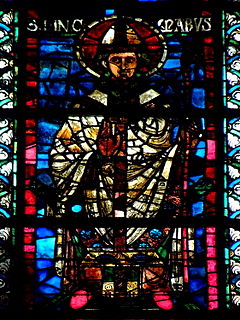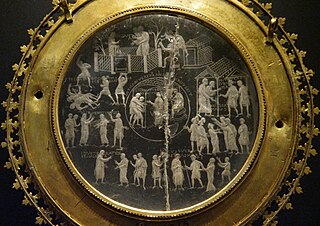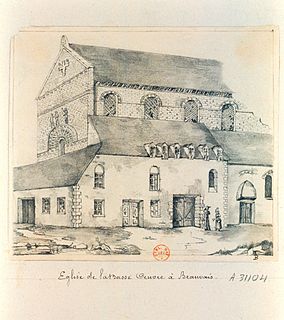Related Research Articles
Pope Nicholas I, called Nicholas the Great, was the bishop of Rome from 24 April 858 until his death. He is remembered as a consolidator of papal authority, exerting decisive influence on the historical development of the papacy and its position among the Christian nations of Western Europe. Nicholas I asserted that the pope should have suzerainty over all Christians, even royalty, in matters of faith and morals.

Lothair II was the king of Lotharingia from 855 until his death. He was the second son of Emperor Lothair I and Ermengarde of Tours. He was married to Teutberga, daughter of Boso the Elder.

Hincmar, archbishop of Reims, was a Frankish jurist and theologian, as well as the friend, advisor and propagandist of Charles the Bald. He belonged to a noble family of northern Francia.
Gottschalk of Orbais of Orbais was a Saxon theologian, monk and poet. Gottschalk was an early advocate for the doctrine of two-fold predestination, an issue that ripped through both Italy and Francia from 848 into the 850's and 860's. Led by his own interpretation of Augustine's teachings on the matter, he claimed the sinfulness of human nature and the need to turn to God with a humility for salvation. He saw himself as a divine vessel calling all of Christianity to repent for decades of Civil War. His attempts of this new Christianisation of Francia ultimately failed, his doctrine was condemned as heresy at the 848 council of Mainz and 849 council of Quierzy. Following his conviction as a heretic Gottschalk remained stubborn to his ideology disobeying the ecclesiastical hierarchy, making him an "actual heretic in the flesh", for this disobedience Gottschalk was placed in monastic confinement; however the shockwaves his ideology sent around Western Christendom refused to stop reverberating, Gottschalk managed to win over more followers and the threat remained up until his death in 868.

Ermentrude of Orléans was the Queen of the Franks by her marriage to Charles II.
Teutberga was a queen of Lotharingia by marriage to Lothair II. She was a daughter of Bosonid Boso the Elder and sister of Hucbert, the lay-abbot of St. Maurice's Abbey.

Charles of Provence or Charles II was the Carolingian King of Provence from 855 until his early death in 863.

Tilpin, Latin Tilpinus, also called Tulpin, a name later corrupted as Turpin, was the bishop of Reims from about 748 until his death. He was for many years regarded as the author of the legendary Historia Caroli Magni, which is thus also known as the "Pseudo-Turpin Chronicle". He appears as one of the Twelve Peers of France in a number of the chansons de geste, the most important of which is The Song of Roland. His portrayal in the chansons, often as a warrior-bishop, is completely fictitious.

Fulk the Venerable was archbishop of Reims from 883 until his death. He was a key protagonist in the political conflicts of the West Frankish kingdom that followed the dissolution of the Carolingian Empire in the late ninth century.
Hucbert was a Frank and son of the count Boso the Elder. Therefore, he was a Bosonid, and the namesake for the Huberterian branch of the family. His rise to power commenced under Lothair I but continued under Lothair II, reaching its apex when his sister Theutberga married Lothair II, a prince of the Carolingian dynasty, the imperial family of Francia. Hucbert also served as the lay-abbot of the Abbey of Saint Maurice-in-Valais. This gave him control over the Mons Iovis pass, the main route between Francia and Italy. Hucbert later gained power in the region of Transjurane Burgundy (859) which is what helped him later to find safety within the kingdom of Charles the Bald.
Hincmar, called the Younger, was the Bishop of Laon in the West Frankish Kingdom of Charles the Bald from 858 to 871. His career is remembered by a succession of quarrels with his monarch and his uncle, archbishop Hincmar of Rheims. After initial loyalty to Charles trouble occurred from 868 due to the allocation of benefices on the see's estates. The conflict grew dangerous as it became embroiled in the larger dispute of Lotharingian succession following Lothair II’s attempted divorce from his wife. Hincmar’s struggle against his king provides a Carolingian example of early Medieval clerical exemption.
De ordine palatii is a treatise written by Hincmar, archbishop of Rheims, in 882 for Carloman II on the occasion of his accession to the throne of West Francia.

The Lothair Crystal is an engraved gem from Lotharingia in northwest Europe, showing scenes of the biblical story of Susanna, dating from 855–869. The Lothair Crystal is an object in the collection of the British Museum.
Wenilo was the archbishop of Rouen from 858. He was an appointee of King Charles the Bald.
Ragenar was the bishop of Amiens from 830 to 833 and again from 834 until his death in 849. His predecessor, Jesse, was initially deposed by the Emperor Louis the Pious in 830 for conspiring with his rebellious son Lothair. In 833 he was restored when Lothair forced his father to make public obeisance at an assembly in Soissons. When Louis regained his position in 834, Jesse was again deposed and this time exiled to Italy, where he died in 836.

Odo I was a West Frankish prelate who served as abbot of Corbie in the 850s and as bishop of Beauvais from around 860 until his death in 881. He was a courtier and a diplomat, going on missions to East Francia and the Holy See.
Waldrada was the mistress, and later the wife, of Lothair II of Lotharingia.

Adventius was the Bishop of Metz from 855 until his death in 875. He was a prominent figure within the courts of the Carolingian kings Lothar II (855–869) and Charles the Bald (840–877).

The 1125 German royal election was the Imperial election which lasted from 24 August to 1 or 2 September 1125, following the death of Henry V. It resulted in the coronation of the Duke of Saxony Lothair of Supplinburg as the King of the Romans by the Archbishop of Mainz, Adalbert on 13 September in Aachen.
The Council of Metz of 863 was arranged by Pope Nicholas I to discuss the divorce case of Lothar II, king of Lotharingia, and his wife Theutberga. The council was mainly attended by Lothar II's supporters, and thus concluded the divorce case in his favour; this decision was later overruled by Pope Nicholas I who suspected foul play. It was the fourth and final council called during the reign of Lothar II. No documents from the council survive, but as the council was controversial it is discussed in other medieval sources such as the letters of Pope Nicholas I, the Annals of St Bertin, the Annals of Fulda and the Liber Pontificalis.
References
- S. Airlie, 'Private bodies and the body politic in the divorce case of Lothar II', Past and Present 1998 pp. 3–38
- K. Heidecker, 'Why Should Bishops Be Involved in Marital Affairs? Hincmar of Rheims on the divorce of King Lothar II (855-869)', in The Community, the Family and the Saint: Patterns of Power in Early Medieval Europe, ed. Hill and Swan (1998).